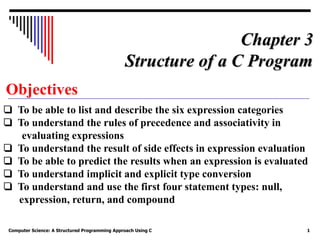
Chap-03-1.ppt
- 1. Computer Science: A Structured Programming Approach Using C 1 Objectives ❏ To be able to list and describe the six expression categories ❏ To understand the rules of precedence and associativity in evaluating expressions ❏ To understand the result of side effects in expression evaluation ❏ To be able to predict the results when an expression is evaluated ❏ To understand implicit and explicit type conversion ❏ To understand and use the first four statement types: null, expression, return, and compound Chapter 3 Structure of a C Program
- 2. Computer Science: A Structured Programming Approach Using C 2 3-1 Expressions An expression is a sequence of operands and operators that reduces to a single value. Expressions can be simple or complex. An operator is a syntactical token that requires an action be taken. An operand is an object on which an operation is performed; it receives an operator’s action. Primary Expressions Postfix Expressions Prefix Expressions Unary Expressions Binary Expressions Topics discussed in this section:
- 3. Computer Science: A Structured Programming Approach Using C 3 An expression always reduces to a single value. Note
- 4. Computer Science: A Structured Programming Approach Using C 4 FIGURE 3-2 Postfix Expressions
- 5. Computer Science: A Structured Programming Approach Using C 5 (a++) has the same effect as (a = a + 1) Note
- 6. Computer Science: A Structured Programming Approach Using C 6 FIGURE 3-3 Result of Postfix a++
- 7. Computer Science: A Structured Programming Approach Using C 7 The operand in a postfix expression must be a variable. Note
- 8. Computer Science: A Structured Programming Approach Using C 8 PROGRAM 3-1 Demonstrate Postfix Increment
- 9. Computer Science: A Structured Programming Approach Using C 9 PROGRAM 3-1 Demonstrate Postfix Increment (continued)
- 10. Computer Science: A Structured Programming Approach Using C 10 FIGURE 3-4 Prefix Expression
- 11. Computer Science: A Structured Programming Approach Using C 11 The operand of a prefix expression must be a variable. Note
- 12. Computer Science: A Structured Programming Approach Using C 12 FIGURE 3-5 Result of Prefix ++a
- 13. Computer Science: A Structured Programming Approach Using C 13 (++a) has the same effect as (a = a + 1) Note
- 14. Computer Science: A Structured Programming Approach Using C 14 PROGRAM 3-2 Demonstrate Prefix Increment
- 15. Computer Science: A Structured Programming Approach Using C 15 PROGRAM 3-2 Demonstrate Prefix Increment (continued)
- 16. Computer Science: A Structured Programming Approach Using C 16 If ++ is after the operand, as in a++, the increment takes place after the expression is evaluated. If ++ is before the operand, as in ++a, the increment takes place before the expression is evaluated. Note
- 17. Computer Science: A Structured Programming Approach Using C 17 FIGURE 3-6 Unary Expressions
- 18. Computer Science: A Structured Programming Approach Using C 18 Table 3-1 Examples of Unary Plus And Minus Expressions
- 19. Computer Science: A Structured Programming Approach Using C 19 FIGURE 3-7 Binary Expressions
- 20. Computer Science: A Structured Programming Approach Using C 20 Both operands of the modulo operator (%) must be integral types. Note
- 21. Computer Science: A Structured Programming Approach Using C 21 PROGRAM 3-3 Binary Expressions
- 22. Computer Science: A Structured Programming Approach Using C 22 PROGRAM 3-3 Binary Expressions (continued)
- 23. Computer Science: A Structured Programming Approach Using C 23 PROGRAM 3-3 Binary Expressions (continued)
- 24. Computer Science: A Structured Programming Approach Using C 24 The left operand in an assignment expression must be a single variable. Note
- 25. Computer Science: A Structured Programming Approach Using C 25 Table 3-2 Expansion of Compound Expressions
- 26. Computer Science: A Structured Programming Approach Using C 26 PROGRAM 3-4 Demonstration of Compound Assignments
- 27. Computer Science: A Structured Programming Approach Using C 27 PROGRAM 3-4 Demonstration of Compound Assignments
- 28. Computer Science: A Structured Programming Approach Using C 28 PROGRAM 3-4 Demonstration of Compound Assignments
- 29. Computer Science: A Structured Programming Approach Using C 29 3-2 Precedence and Associativity Precedence is used to determine the order in which different operators in a complex expression are evaluated. Associativity is used to determine the order in which operators with the same precedence are evaluated in a complex expression. Precedence Associativity Topics discussed in this section:
- 30. Computer Science: A Structured Programming Approach Using C 30 PROGRAM 3-5 Precedence
- 31. Computer Science: A Structured Programming Approach Using C 31 PROGRAM 3-5 Precedence
- 32. Computer Science: A Structured Programming Approach Using C 32
- 33. Computer Science: A Structured Programming Approach Using C 33 FIGURE 3-8 Left-to-Right Associativity
- 34. Computer Science: A Structured Programming Approach Using C 34 FIGURE 3-9 Right-to-Left Associativity
- 35. So you can have things like: int i =1; int j =2; i = j*= 2; // i = j = 4 after i += i + j+=2; // j=6, i = 10 // after Computer Science: A Structured Programming Approach Using C 35
- 36. You can actually say int i, sum; i = sum = 3 +1; // Right to left // associativity And i will equal 4, but it is not good programming practice. Computer Science: A Structured Programming Approach Using C 36
Notas do Editor
- Associativity used when operators have same precedence: the += type operatorrs use R->L associativity, basic math operators like * use L->R